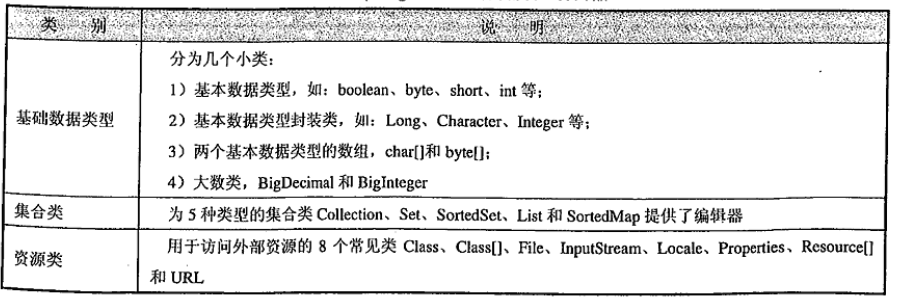springMVC4(9)屬性編輯器剖析入參型別轉換原理
我們通過Http請求提交的引數都以字串的形式呈現,但最終在springMVC的方法入參中,我們卻能得到各種型別的資料,包括Number、Boolean、複雜物件型別、集合型別、Map型別等,這些都是springMVC內建的資料型別轉換器幫我們完成的。springMVC的將請求資料繫結到方法入參的流程如下所示:
在本文裡,我們通過屬性編輯器來理解springMVC的資料轉換、繫結過程。
PropertyEditorRegistrySupport
而對於常見的資料型別,Spring在PropertyEditorRegistrySupport中提供了預設的屬性編輯器,這些常見的資料型別如下圖所示:

在PropertyEditorRegistrySupport中,有兩個重要的Map型別成員變數:
1. private Map<Class<?>, PropertyEditor> defaultEditors
2.
private Map<Class<?>, PropertyEditor> customEditors:用於儲存使用者自定義的屬性編輯器,元素的鍵值和defaultEditors一致。
在PropertyEditorRegistrySupport中,有一個重要的成員方法:createDefaultEditors()來建立預設的屬性編輯器,它的定義如下所示:
/**
* Actually register the default editors for this registry instance.
*/ PropertyEditor
PropertyEditor是Java原生的屬性編輯器介面,它的核心功能是將一個字串轉換為一個java物件。
它的定義和常用方法如下所示:
public interface PropertyEditor {
//設定屬性的值,基本屬性型別要以包裝類傳入
void setValue(Object value);
//返回屬性的值,基本資料型別會被封裝成相應的包裝類
Object getValue();
//為屬性提供一個表示初始值的字串,屬性編輯器以此值作為屬性的預設值
String getJavaInitializationString();
//將屬性物件用一個字串表示,一遍外部的屬性編輯器能以視覺化的方式顯示。
//預設返回null,表示改屬性不能以字串形式表示
String getAsText();
//利用所給字串text更新屬性內部的值
void setAsText(String text) throws java.lang.IllegalArgumentException;
}例項解析自定義屬性編輯器
1. 自定義編輯器類
它的一個核心實現類是PropertyEditorSupport,如果我們要編寫自定義的屬性編輯器,只需要繼承這個類,然後重寫setAsText方法即可。下面我們來看一個自定義屬性編輯器的例項:嘗試將字串“myName,1995-01-01,15k”轉換為Person POJO物件,Person物件的定義如下:
package com.mvc.model;
import java.util.Date;
import org.springframework.format.annotation.DateTimeFormat;
import org.springframework.format.annotation.NumberFormat;
public class Person {
private String name;
private Date birthday;
private Long salary;
//ignore getter and setter
@Override
public String toString() {
return "Person [name=" + name + ", birthday=" + birthday + ", salary="
+ salary + "]";
}
}下面是我們自定義的屬性編輯器:
public class MyEditor extends PropertyEditorSupport {
@Override
public void setAsText(String text) throws IllegalArgumentException {
String[] values = text.split(",");
Person person = new Person();
person.setName(values[0]);
try {
person.setBirthday(new SimpleDateFormat("yyyy-MM-dd").parse(values[1]));//格式化字串並解析成日期型別
} catch (ParseException e) {
e.printStackTrace();
}
person.setSalary(Long.valueOf(values[2].replace("k", "000")));//轉換為工資格式
setValue(person);//呼叫setValue來將我們的Person物件設定為編輯器的屬性值
super.setAsText(text);
}
}2. 註冊編輯器
自定義完屬性編輯器後,我們需要將其註冊才能生效,SpringMVC中使用自定義的屬性編輯器有3種方法:
1. Controller方法中新增@InitBinder註解的方法
例項:
@InitBinder
public void initBinder(WebDataBinder binder) {
binder.registerCustomEditor(Person.class, new MyEditor());
}2. 實現 WebBindingInitializer介面
方法1是針對特定的控制器的,如果我們需要對全域性控制器生效,可以編寫自己的WebBindingInitializer,然後在spring容器中註冊,如下所示:
public class MyWebBindingInitializer implements WebBindingInitializer {
@Override
public void initBinder(WebDataBinder binder, WebRequest request) {
binder.registerCustomEditor(Dept.class, new CustomDeptEditor());
}
}在容器中註冊:
<bean class="org.springframework.web.servlet.mvc.method.annotation.RequestMappingHandlerAdapter">
<property name="webBindingInitializer">
<bean class="com.mvc.editor.MyWebBindingInitializer" />
</property>
</bean>3. @ControllerAdvice註解
我們可以通過此註解配置一個控制器增強,
@ControllerAdvice
public class InitBinderControllerAdvice {
@InitBinder
public void initBinder(WebDataBinder binder) {
binder.registerCustomEditor(Dept.class, new CustomDeptEditor());
}
}我們需要將其納入<context:component-scan>的掃描路徑中才能生效。
從上面的分析我們能看到,springMVC註冊了大量的資料型別編輯器,恰是通過這些屬性編輯器,springMVC幫助我們完成了請求引數字串到入引數據的繫結。在一篇文章裡,我們會談到SpringMVC對新的轉換器框架的支援。
相關推薦
springMVC4(9)屬性編輯器剖析入參型別轉換原理
我們通過Http請求提交的引數都以字串的形式呈現,但最終在springMVC的方法入參中,我們卻能得到各種型別的資料,包括Number、Boolean、複雜物件型別、集合型別、Map型別等,這些都是springMVC內建的資料型別轉換器幫我們完成的。spring
Spring經常使用屬性的註入及屬性編輯器
edt 註入 nim jsm fin v2x avt ket jsf 對於對象的註入,我們使用ref方式,能夠指定註入的對象。以下看下對於基本類型的註入。以及當spring無法轉換基本類型進行註入時,怎樣編寫一個相似轉換器的東西來完畢註
2.9-vim編輯器
編輯器 vim vim編輯器 vi:Visual Interface,文本編輯器 文本:ASCII,Unicode 文本編輯種類: 行編輯器:sed 全屏編輯器:nano,vi VIM - Vi IMproved使用VIM vim:模式化的編輯
Spring自定義屬性編輯器
tex java block tom support bar white sim name bean類: [html] view plain copy package com.zm.bean; import java.util.Date; pu
9.屬性選擇器
min nbsp .html input http 使用 text 按鈕 utf-8 掌握: [attribute] 含有指定屬性 [attribute=value] 含有指定屬性且值固定 了解: [attribute!=value] 指定屬性不為指定值(包含
Confluence 6 在編輯器中控制參數的顯示
Confluence你可以決定宏參數在 Confluence 編輯器中如何進行顯示的。在默認的情況下,在宏占位符下盡可能顯示能顯示的所有參數:你可以控制這裏顯示的參數數量,通過這種控制你可能盡量的為編輯者提供有效的信息。例如,在 Confluence 的經過宏中有 2 個參數,title 和 icon。我們考
Java spring自定義屬性編輯器
匯入測試jar包junit-4.8.2.jar 字串自定義Date轉化 1.新增分拆配置檔案applicationContext_editor.xml <?xml version="1.0" encoding="UTF-8"?> <beans xmlns="
springMVC自定義屬性編輯器
自定義springMVC的屬性編輯器主要有兩種方式,一種是使用@InitBinder標籤在執行期註冊一個屬性編輯器,這種編輯器只在當前Controller裡面有效;還有一種是實現自己的 WebBindingInitializer,然後定義一個 AnnotationMethodHandlerAdapter的b
Spring常用屬性的注入及屬性編輯器
對於物件的注入,我們使用ref方式,可以指定注入的物件,下面看下對於基本型別的注入,以及當spring無法轉換基本型別進行注入時,如何編寫一個類似轉換器的東西來完成注入。一,基本型
深入分析Spring屬性編輯器(預設屬性編輯器和自定義屬性編輯器)
在Spring配置檔案或配置類裡,我們往往通過字面值為Bean各種型別的屬性提供設定值:不管是double型別還是int型別,在配置檔案中都對應字串型別的字面值。BeanWrapper填充Bean屬性時如何將這個字面值轉換為對應的double或int等內部型別呢?我們可以隱約
SpringMVC中的時間屬性編輯器
自定義時間格式 /** * 時間屬性編輯器 * @param bin */ @InitBinder public void initBinder(Se
詳解spring自定義屬性編輯器
Spring DI注入的時候可以把普通屬性注入進來,但是像Date型別的就無法被識別。這時可以通過Spring的屬性編輯器把配置檔案中的字串轉化成相應的物件進行注入。 Spring有自帶的屬性編輯器,我們也可以寫自定義的屬性編輯器 自定義屬性編輯器: 繼承java.
spring4.0之後,自定義屬性編輯器的配置變化
問題:spring中注入時間日期(java.util.Date)型別的屬性的時候需要進行型別轉換,因為spring不能直接注入Date型別。之前學習spring的時候是學的spring 2.5的版本,但是今天把spring的包都換成了spring 4.2 的,發現之前的出
spring自定義屬性編輯器使用dome
Spring xml配置 <bean class="org.springframework.beans.factory.config.CustomEditorConfigurer"> <property name="propertyEditorRegist
Spring整理3 -- 自定義屬性編輯器
在我們注入屬性時,遇到是日期型別,如果按普通屬性去注入,則會報錯,那我們該怎麼解決?解決辦法:自定義屬性編輯器。 什麼是屬性編輯器,作用? 自定義屬性編輯器,spring配置檔案中的字串轉換成相應的物件進行注入spring已經有內建的屬性編輯器,我們可以根據需求自己定義屬性編
Spring的自定義屬性編輯器
什麼是屬性編輯器:自定義屬性編輯器就是將Spring的字串轉換成相對應的物件進行注入,Spring已經有了內建的屬性編輯器,我們可以自己定義屬性編輯器。 如何定義屬性編輯器: (1)繼承PropertyEditorSupport,重寫setAsText()方法。 pack
Spring屬性編輯器
1 屬性編輯器 對於屬性編輯器我們一般分為Core Context的使用和MVC的使用兩種 Core Context的使用 Spring Core Context其實也使用ConversionService,但是是非強制的。 Spring在讀取x
說說 Spring 的屬性編輯器
在 Spring 配置檔案中,我們往往通過字面值設定 Bean 各種型別的屬性值 ,這個功能是通過屬性編輯器實現的。 任何實現了 java.beans.PropertyEditor 介面的類都是屬性編輯器 。 它可以將外部需要設定的值轉換為 JVM 內部的對應
springmvc屬性編輯器和自定義引數解析器
自定義的引數解析器 Springmvc呼叫action方法過程,通過引數解析器: Springmvc自帶了很多的引數解析器,一般能滿足需求。可以自定義引數解析器: 需求: 從session中取當前使用者身份資訊。 實現: 通過形參定義ActiveUser ac
CreatorPrimer(9)|優化編輯器
Cocos Creator遊戲開發主要是使用JavaScript語言,這裡向大家推薦Visual Studio Code和Webs
